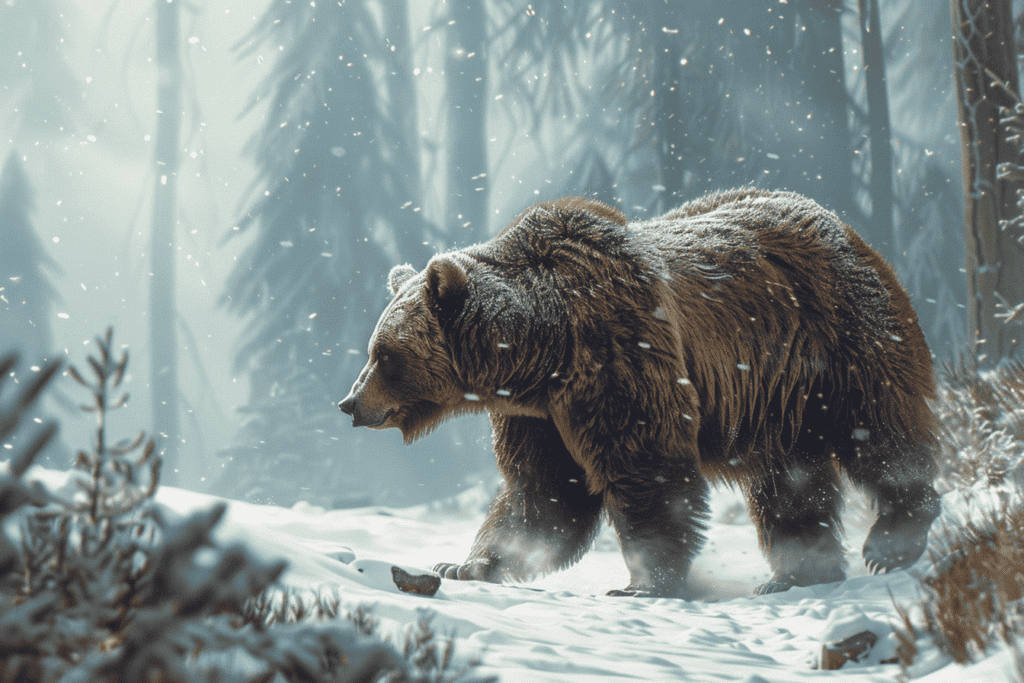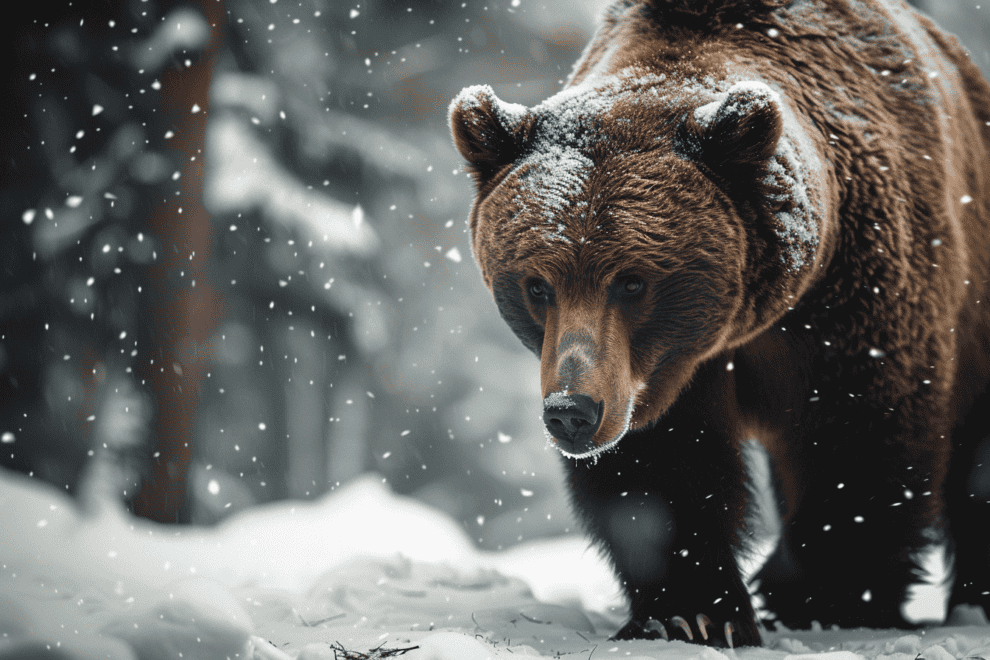Winter is a time of rest and rejuvenation for many animals, and grizzly bears are no exception. These magnificent creatures have developed a unique adaptation to survive the harsh winter months, known as hibernation.
During this period, grizzly bears slow down their metabolism, heart rate, and breathing to conserve energy and survive on their fat reserves.

One of the most remarkable aspects of hibernation in grizzly bears is their slow heartbeat.
While a human’s resting heart rate is typically around 60-100 beats per minute, a hibernating grizzly bear’s heart rate can drop to as low as 5 beats per minute.
This remarkable feat of nature allows them to conserve energy and survive for months without food or water.
Grizzly bears are fascinating creatures, and their winter slumber is a testament to their incredible adaptability. As the winter months approach, these majestic animals retreat to their dens and enter a state of torpor, a mild form of hibernation.
During this time, they slow down their heart rate, breathing, and metabolism to conserve energy and survive the winter.
The slow heartbeat of hibernating grizzly bears is just one of the many incredible adaptations that make them such an important part of our natural world.
The Science of Hibernation
Hibernation is a fascinating phenomenon that helps animals survive the harsh winter months.
During hibernation, animals like grizzly bears and ground squirrels enter a state of deep sleep where their body temperature, heart rate, and metabolism slow down significantly. This allows them to conserve energy and survive on their fat reserves until spring arrives.
Grizzly bears have a unique hibernation pattern compared to other hibernators. While ground squirrels and other small animals drop their body temperature almost to freezing during hibernation, grizzly bears’ body temperature drops by only about 6°C.
Yet, their metabolism and oxygen consumption drop by 75%, indicating that another mechanism is involved in their hibernation.
Grizzly Bears: Masters of Energy Conservation

Grizzly bears are remarkable creatures that have evolved to survive in some of the harshest environments on the planet.
One of the most impressive adaptations of grizzly bears is their ability to conserve energy during the winter months. By slowing down their metabolic processes and hibernating, grizzly bears can survive months without food or water.
During the winter months, grizzly bears enter a state of hibernation, which allows them to conserve energy and survive the harsh conditions. As the temperatures drop and food becomes scarce, grizzly bears will start to prepare for hibernation by increasing their food intake and storing fat.
This process is known as hyperphagia, and it allows grizzly bears to gain up to 3 pounds of body weight per day.
Once the winter months arrive, grizzly bears will enter a state of hibernation, which allows them to conserve energy and survive until the spring.
During hibernation, grizzly bears will slow down their metabolic processes, which reduces their heart rate and body temperature. Grizzly bears can lower their heart rate from 40-50 beats per minute to as low as 8-19 beats per minute during hibernation.
The Role of Body Fat and Hyperphagia
The ability of grizzly bears to survive the winter months is largely due to their ability to store fat. Grizzly bears can store up to 300 pounds of fat, which provides them with the energy they need to survive until the spring.
During hibernation, grizzly bears will use their stored fat as a source of energy, which allows them to survive without food or water.
Hyperphagia plays a critical role in the survival of grizzly bears during the winter months. By increasing their food intake and storing fat, grizzly bears can survive for months without food or water. This adaptation allows grizzly bears to survive in some of the harshest environments on the planet.
The Wonders of Bear Biology

Grizzly bears are remarkable creatures that can slow down their breathing and heart rate by about 75% for months at a time while maintaining a high body temperature. Scientists have been studying them for years to unlock the secrets of their hibernation.
Recent studies have shown that genes play a significant role in this process.
Researchers have discovered that during hibernation, grizzly bears undergo differential gene expression, meaning that certain genes are upregulated while others are downregulated. This transcriptional remodeling occurs in metabolic tissues such as muscle and liver tissue.
The genes that are upregulated help the bears to break down stored fat for energy, while those that are downregulated protect the bears’ organs from damage caused by fasting.
One study found that grizzly bears show remarkable gene control before and during hibernation. The researchers discovered that genes responsible for glucose uptake and insulin signaling were upregulated during hibernation, which could provide insights into diabetes and obesity research.
The Impact on Human Medicine
The study of hibernating bears has the potential to impact human medicine in several ways. For example, understanding how bears can maintain muscle mass and bone density during hibernation could lead to new treatments for osteoporosis and muscle atrophy.
Additionally, the discovery that grizzly bears undergo transcriptional remodeling during hibernation could provide insights into human gene expression and disease.
By studying the genes that are upregulated and downregulated during hibernation, researchers may be able to identify new drug targets for treating diseases such as cancer and Alzheimer’s.
Tracking and Studying Hibernating Bears

Scientists have been studying hibernating bears for many years, trying to understand the mechanisms behind their slow heartbeat and metabolism.
With modern research techniques, they have been able to monitor hibernating bears continuously, both in the wild and in captivity.
One such research facility is the Washington State University (WSU) Bear Research, Education, and Conservation Center. Here, researchers have been studying grizzly bears for many years, using advanced monitoring tools to track their heart rate, body temperature, and other vital signs during hibernation.
Insights from the Wild and Captivity
Through these experiments, scientists have gained valuable insights into the physiology of hibernating bears. For example, they have discovered that bears’ heart rate can drop from 40-50 beats per minute to as low as 10 beats per minute during hibernation. They have also found that bears’ metabolism can slow down by up to 75% during hibernation, allowing them to survive for months without eating or drinking.
Frequently Asked Questions

What changes occur in a grizzly bear’s body to allow it to go without water during hibernation?
During hibernation, grizzly bears can go without water, food, or even urination for several months. This is because their metabolism slows down, and their body temperature drops, allowing them to conserve energy. They also recycle their urine, which helps them retain water.
The bear’s body undergoes several changes to adapt to this extreme condition, including a decrease in heart rate, breathing rate, and metabolic rate.
Can you explain the process that allows bears to wake up healthy after months of hibernation?
When grizzly bears emerge from hibernation, they are healthy and ready to resume their normal activities. This is because their body undergoes several changes during hibernation that allow them to conserve energy and protect their vital organs.
For example, they recycle their urine, which helps them retain water and nutrients. They also break down their fat reserves to provide energy for their body. When they wake up, they slowly start to eat and drink again, allowing their body to recover from the long period of hibernation.
What are the differences between a grizzly bear’s heart rate when active compared to during hibernation?
When grizzly bears are active, their heart rate can range from 40 to 50 beats per minute. During hibernation, their heart rate drops to 8 to 19 beats per minute, allowing them to conserve energy. This slow heart rate is remarkable and helps the bear survive the long period of hibernation.
What would happen in the wild if a hibernating grizzly bear were to be disturbed?
If a hibernating grizzly bear were to be disturbed, it could be dangerous for both the bear and the person.
When disturbed, the bear’s heart rate and breathing rate can increase rapidly. This can cause them to wake up and become aggressive because the bear perceives the disturbance as a threat and reacts accordingly.
Therefore, it is important to avoid disturbing hibernating bears and to give them their space.
How does the duration of hibernation affect a grizzly bear’s overall health and lifespan?
The duration of hibernation can affect a grizzly bear’s overall health and lifespan.
If the bear hibernates for too long, it can cause them to lose too much weight and become weak. This can make it difficult for them to survive the winter or reproduce in the spring.
On the other hand, if the bear hibernates for too short a period, they may not conserve enough energy to survive the winter.
Therefore, the duration of hibernation is critical for a grizzly bear’s overall health and survival.
In what ways do grizzly bears prepare for the hibernation period?
Grizzly bears prepare for the hibernation period by eating as much food as possible during the summer and fall. This allows them to build up their fat reserves, which they will use for energy during hibernation.
They also look for a safe and secure place to hibernate, such as a den or a cave. Once they find a suitable location, they will prepare it by lining it with grass, leaves, and other materials to make it more comfortable. Finally, they will enter hibernation, where they will remain until the spring.









